SSL/TLS
Secure communication over insecure channels
Karol Babioch <karol@babioch.de>
NULL 911 - July 31, 2019
“Watch out for the padlock”

+ a lot of details ...
About me
- Open Source Enthusiast
- Engineering Infrastructure @ SUSE
- ❤ Crypto, authentication, IT security, ...
- karol@babioch.de
- 749A 65CD 479F 3215
- kbabioch
- Karol Babioch
- Karol Babioch
- Karol Babioch
- karolbabioch
- kbabioch
Agenda
- Protocol overview
- Handshake
- Attacks
- TLS 1.3
- Good practice and recommendations
- Q&A
Resources
The SSL/TLS “bible”
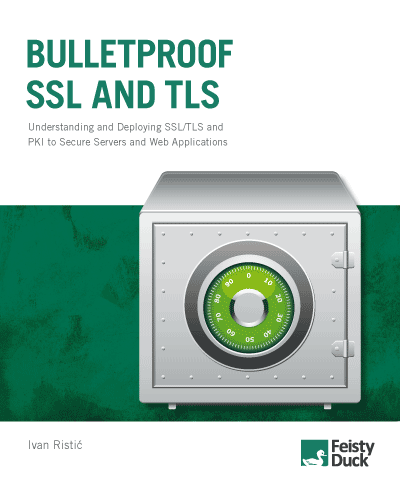
Source: Bulletproof SSL and TLS by Ivan Ristić
SSL/TLS overview
Used everyhwere ...
- on top of other protocols (https, imaps, etc.)
- in many applications (VPN, mail, chat, etc.)
- implemented for basically all devices
- implemented for operating systems
SSL vs. TLS
- Two names for essentially the same protocol
- Technically correct: TLS
- Most people still use: SSL
- → Nevermind
Secure communication over insecure channels
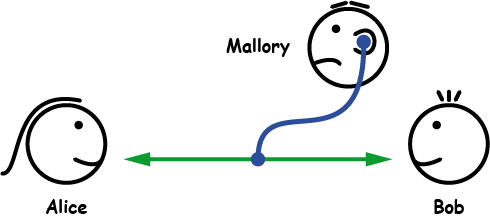
Source: elektronik-kompendium.de
Goals of TLS
- Cryptographic security
- Interoperability
- Extensibility
- Efficiency
Security provided by TLS
- Confidentiality
- Integrity
- Authenticity
Networking layer
| # | OSI layer | Description | Protocols |
|---|---|---|---|
| 7 | Application | Application data | HTTP, SMTP, IMAP |
| 6 | Presentation | Data representation, encryption | SSL/TLS |
| 5 | Session | Management of multiple connections | - |
| 4 | Transport | Delivery of packets and streams | TCP, UDP |
| 3 | Network | Routing and delivery of datagrams | IP, IPsec |
| 2 | Data link | Local data connection | Ethernet |
| 1 | Physical | “Cables” | CAT5 |
Protocol history
| Version | Year | Description |
|---|---|---|
| SSL 1 | - | Never publicly released |
| SSL 2 | 1994 | Broken by design (no security experts involved) |
| SSL 3 | 1995 | New protocol design |
| TLS 1.0 | 1999 | Migration from Netscape to IETF, minor changes only |
| TLS 1.1 | 2006 | Security fixes, TLS extensions |
| TLS 1.2 | 2008 | Authenticated encryption, removed hardcoded primitives |
| TLS 1.3 | 2018 | A lot of changes, see later! |
Crypto 101
- Hash functions
- Symmetric cryptography
- Asymmetric cryptography
(Cryptographic) hash functions
- (Fixed-size) digest (“hash value”) for any input
- Input → digest (easy)
- Digest → input (difficult)
- Unlikely for two messages to have same digest
(Cryptographic) hash functions
Source: Wikipedia
(Cryptographic) hash function
- ≠ encryption
- Also referred to as: One way hash functions
- Use cases: integrity, signatures, ...
- Examples: SHA1, SHA2 (256, 384, 512), SHA3, MD5
Symmetric cryptography
- Secret key to encrypt plaintext → ciphertext
- Same key to decrypt ciphertext → plaintext
- “Intuitive” to understand
Symmetric cryptography
Source: Wikipedia
Symmetric cryptography
- Types of ciphers: block vs. stream
- Modes of operation: ECB, CBC, GCM, ...
- Typical key lengths: 64, 128, 192, 256 bits
- Examples: AES, DES, 3DES, RC4, Blowfish, ...
- Key management does not scale well
Asymmetric cryptography
- Different keys for encryption and decryption
- Key pair: private and public key
Asymmetric cryptography
Source: Wikipedia
Public key encryption
- Requires one key pair (of recipient)
- Message encrypted with public key
- Message decrypted with private key
- Only recipient has private key
Public key encryption
Source: Wikipedia
Digital signatures
- Requires one key pair (of sender)
- Digital signature = encrypted hash of message
- Recipient needs to know public key of sender
- Proves that sender has control over private key
Digital signatures
Source: Wikipedia
Key agreement / shared secret
- Requires two key pairs
- Both parties can derive same secret
- Eavesdropper cannot derive secret
Key agreement / shared secret
Source: Wikipedia
Asymmetric cryptography
- Details (= math) are complex and tricky
- Examples: RSA, Diffie-Hellman (DH), Elliptic curve cryptography (ECC), ...
- Typical key lengths: 1024, 2048, 4096 bits
- Key management scales way better
Hybrid cryptosystem
- Combination of symmetric & asymmetric crypto
- Asymmetric crypto to establish connection and agree on key
- Symmetric encryption for actual transmission of data
- SSL/TLS is a hybrid cryptosystem
Hybrid cryptosystem
- SSL/TLS
- IPsec
- OpenPGP
- Messenger
- ...
Hybrid cryptosystem
| Symmetric | RSA/DSA/DH | ECC | Hash function |
|---|---|---|---|
| 80 | 1024 | 160 | 160 |
| 112 | 2048 | 224 | 224 |
| 128 | 3072 | 256 | 256 |
| 256 | 15360 | 512 | 512 |
Comparison of “strength”
Source: Bulletproof SSL and TLS, p. 18
SSL/TLS handshake
SSL/TLS handshake
- Agree on capabilities and parameters
- Authentication (certificates)
- Agree on shared master secret
- Verify that handshake has not been modified
SSL/TLS handshake
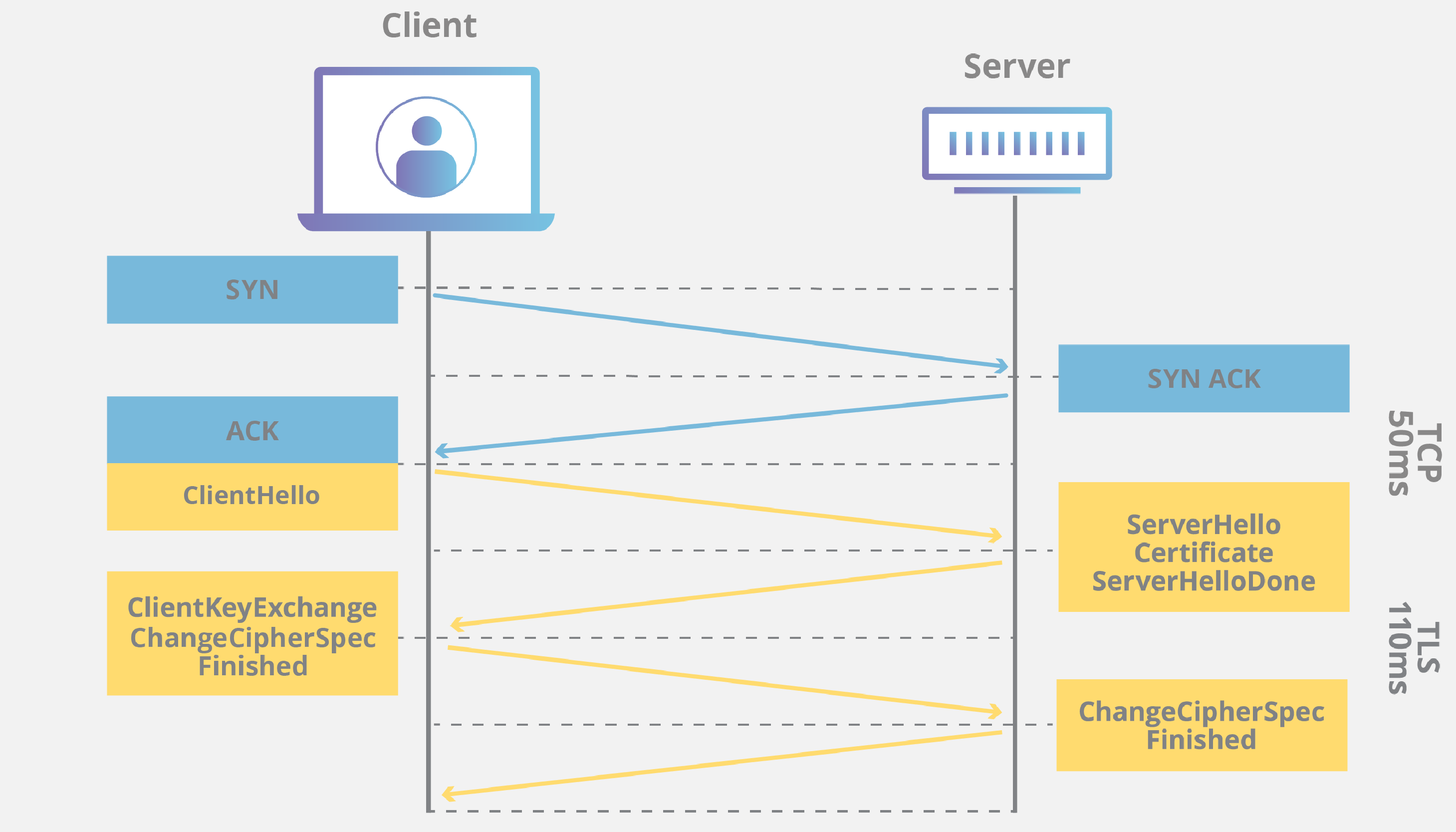
Source: Cloudflare
ClientHello
Handshake protocol: ClientHello
Version: TLS 1.2
Random
Client time: May 22, 2030 02:43:46 GMT
Random bytes: b76b0e61829557eb4c611adfd2d36eb232dc1332fe29802e321ee871
Session ID: (empty)
Cipher Suites
Suite: TLS_ECDHE_RSA_WITH_AES_128_GCM_SHA256
Suite: TLS_DHE_RSA_WITH_AES_128_GCM_SHA256
Suite: TLS_RSA_WITH_AES_128_GCM_SHA256
Suite: TLS_ECDHE_RSA_WITH_AES_128_CBC_SHA
Suite: TLS_DHE_RSA_WITH_AES_128_CBC_SHA
Suite: TLS_RSA_WITH_AES_128_CBC_SHA
Suite: TLS_RSA_WITH_3DES_EDE_CBC_SHA
Suite: TLS_RSA_WITH_RC4_128_SHA
Compression methods
Method: null
Extensions
Extension: server_name
Hostname: www.feistyduck.com
Extension: renegotiation_info
Extension: elliptic_curves
Named curve: secp256r1
Named curve: secp384r1
Extension: signature_algorithms
Algorithm: sha1/rsa
Algorithm: sha256/rsa
Algorithm: sha1/ecdsa
Algorithm: sha256/ecdsa
ServerHello
Handshake protocol: ServerHello
Version: TLS 1.2
Random
Server time: Mar 10, 2059 02:35:57 GMT
Random bytes: 8469b09b480c1978182ce1b59290487609f41132312ca22aacaf5012
Session ID: 4cae75c91cf5adf55f93c9fb5dd36d19903b1182029af3d527b7a42ef1c32c80
Cipher Suite: TLS_ECDHE_RSA_WITH_AES_128_GCM_SHA256
Compression method: null
Extensions
Extension: server_name
Extension: renegotiation_info
Certificate
- Optional, but typically sent
- Typically X509 certificate chain
- Chain without root
- in ASN.1 DER encoding
ServerKeyExchange
- Additional data for key exchange
- Content depends on cipher suite, etc.
ServerHelloDone
- All done from server side
- Wait for further messages from client
ClientKeyExchange
- Client data for key exchange
ChangeCipherSpec
- Switching to encryption
Finished
- Signal that handshake is complete
- Used to verify integrity of handshake
Client authentication
- Server can request authentication from client
- Communicated via CertificateRequest message
Server Name Indication (SNI)
- Client sends “hostname” along with ClientHello
- Server can respond with correct certificate, etc.
Authentication
- Implicitly authentication during handshake
- Tightly coupled with key exchange
- Details require more cryptographic know-how
- RSA, DH, DHE, ECDH, ECDHE, ...
- ≠ RSA / DSA / ECDSA certificates
Handshake (RSA)
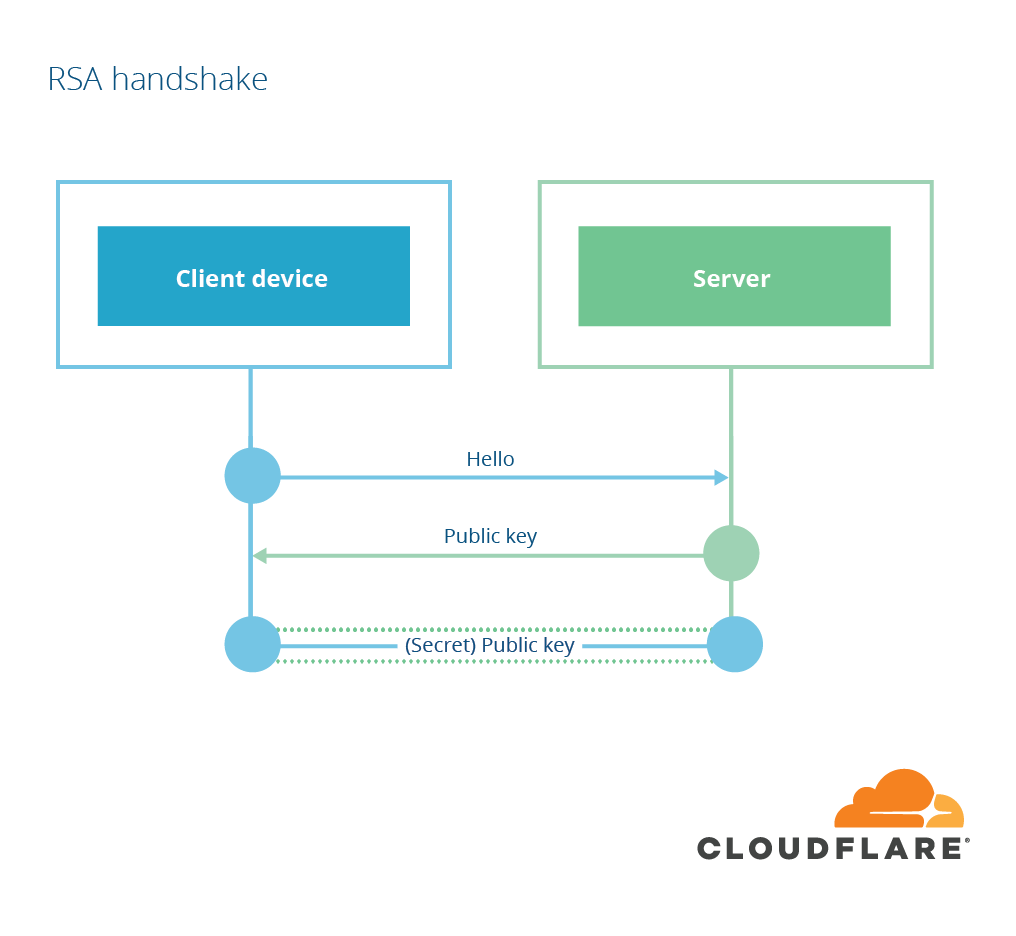
Source: Cloudflare
Handshake (RSA)
- Client generates secret
- Encrypts it with server's public key
- Only server can decrypt it
- Problem: Forward secrecy
- Problem: Bleichenbacher “attack”
Handshake (DH/DHE/ECDH/ECDHE)
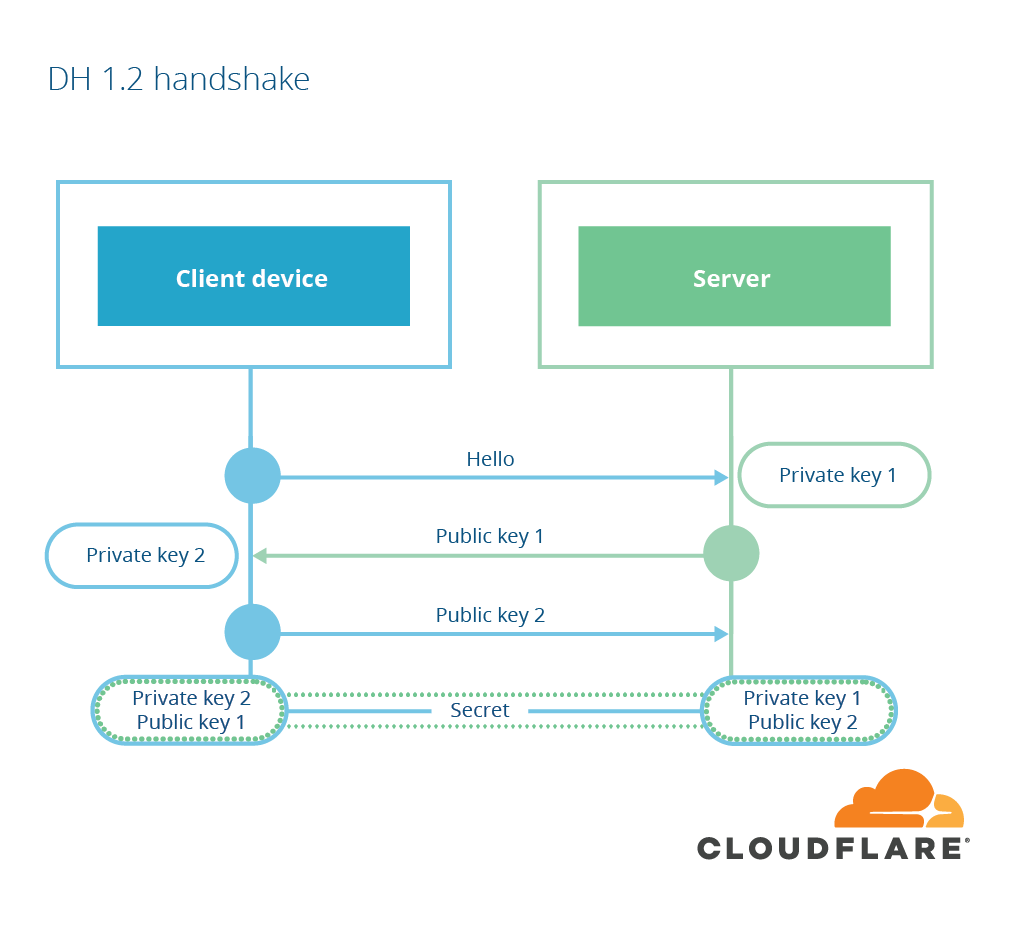
Source: Cloudflare
Handshake (DH/DHE/ECDH/ECDHE)
- Shared secret is derived via Diffie-Hellmann
- Both parties contribute to the shared secret
- Signature (e.g. RSA) is used for integrity
- Forward Secrecy
Session resumption
- Initial handshake is “expensive”
- Idea: Re-use already existing sessions
- Two concepts: Session IDs & session tickets
Session IDs
- Both parties store context for some period of time
- Server provides session ID in ServerHello
- Client remembers session ID and sends it with next ClientHello
- Server accepts session ID
- Regenerate session keys
- ...
Session IDs

Source: Cloudflare
Session tickets
- Only later introduced (RFC 4507, RFC5077)
- State is kept by the client (encrypted)
- Otherwise similar to session IDs
Session tickets
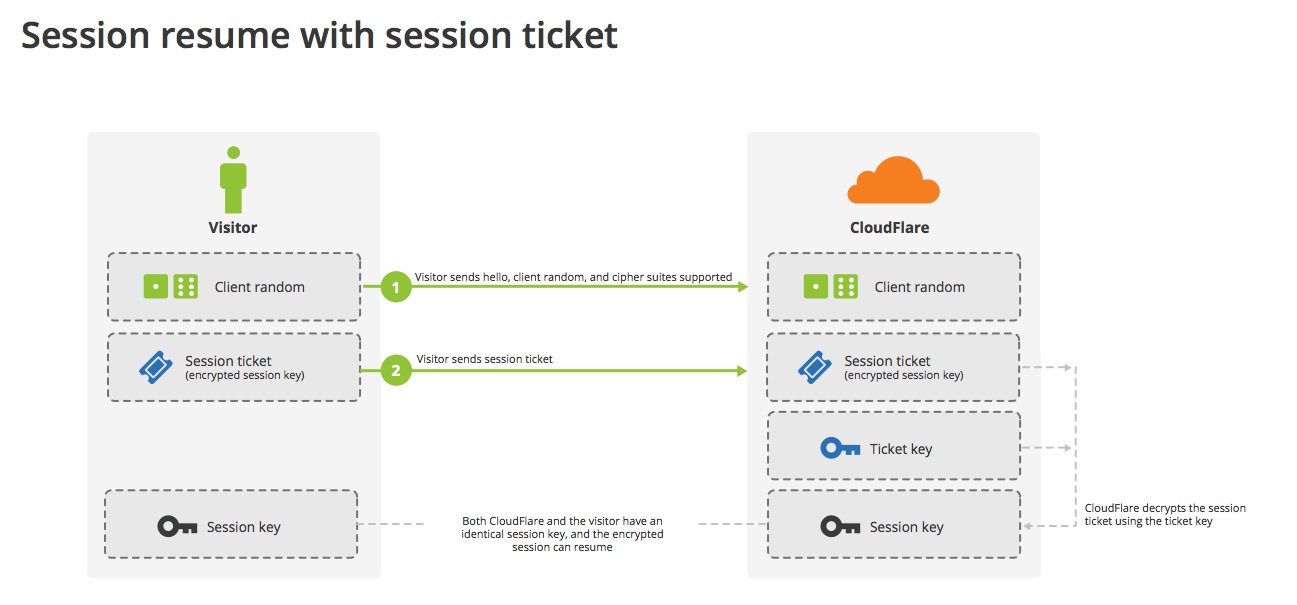
Source: Cloudflare
Session tickets
generate session ticket keys randomly, distribute them to the servers without ever touching persistent storage and rotate them frequently.
Session resumption
TLS Session Resumption: Full-speed and SecureAttacks on SSL/TLS
Classes of attacks
- Implementation issues
- Protocol attacks
Implementation issues
- Flaws with certification validation
- Random number generation, entropy, ...
- Heartbleed
- Export grade crypto (FREAK, Logjam, ...)
- Downgrade attacks
- ...
Protocol attacks
- BEAST
- Lucky 13
- RC4 weaknesses
- POODLE
- SLOTH
- DROWN
- Sweet32
- NSA's Bullrun
- ...
Protocol attacks
- Details are very complex
- Some attacks are easy to exploit
- Some attacks are (mostly) theoretical
- Cryptography is constantly evolving
Importance of crypto agility
- BEAST attack announced in 2011
- → block ciphers unsafe to use with ≤ TLS 1.0
- Support for TLS 1.1 & TLS 1.2 was lacking
- Recommendation: Use RC4
- → In 2013 ~ 50% RC4 usage
Importance of crypto agility
- RC4 is a symmetric stream cipher
- Was designed by Ron Rivest in 1987
- Easy to implement and very fast
- Biases & weaknesses
- More weaknesses became known ~ 2013
Importance of crypto agility
- TLS 1.1 and above are not affected by BEAST
- Block ciphers with AEAD
- Implementation and deploy rates have changed
- 2015 RFC 7465 forbid further usage of RC4 in TLS
- Modern browsers removed RC4 during 2016
- → Currently only ~ 15% RC4 support
- → Good security, broken appliances
TLS 1.3
What's new?
TLS 1.3
- Latest version of TLS protocol
- Started in 2013, finalized in 2018
- Faster, easier, more secure
- Already implemented and widely used ...
- RFC8446
Improved security
- Removed RSA key exchange in favor of DHE
- Diffie-Hellman named groups
- Removed troublesome ciphers
- Only AEAD ciphers
- Removed PKCS#1 v1.5 in favor of RSA-PSS
- Signing entire handshake
- Simplified cipher suite negotiation
Improved performance
- 1-RTT mode
- 0-RTT resumption
1-RTT mode
- Reduced options for cipher suite negotation
- Parameters for key exchange are easy to guess (
ECDHE
withX25519
orP-256
) - Client send DH key shares in the first message
- When server does not support the key shares, server can send
HelloRetryRequest
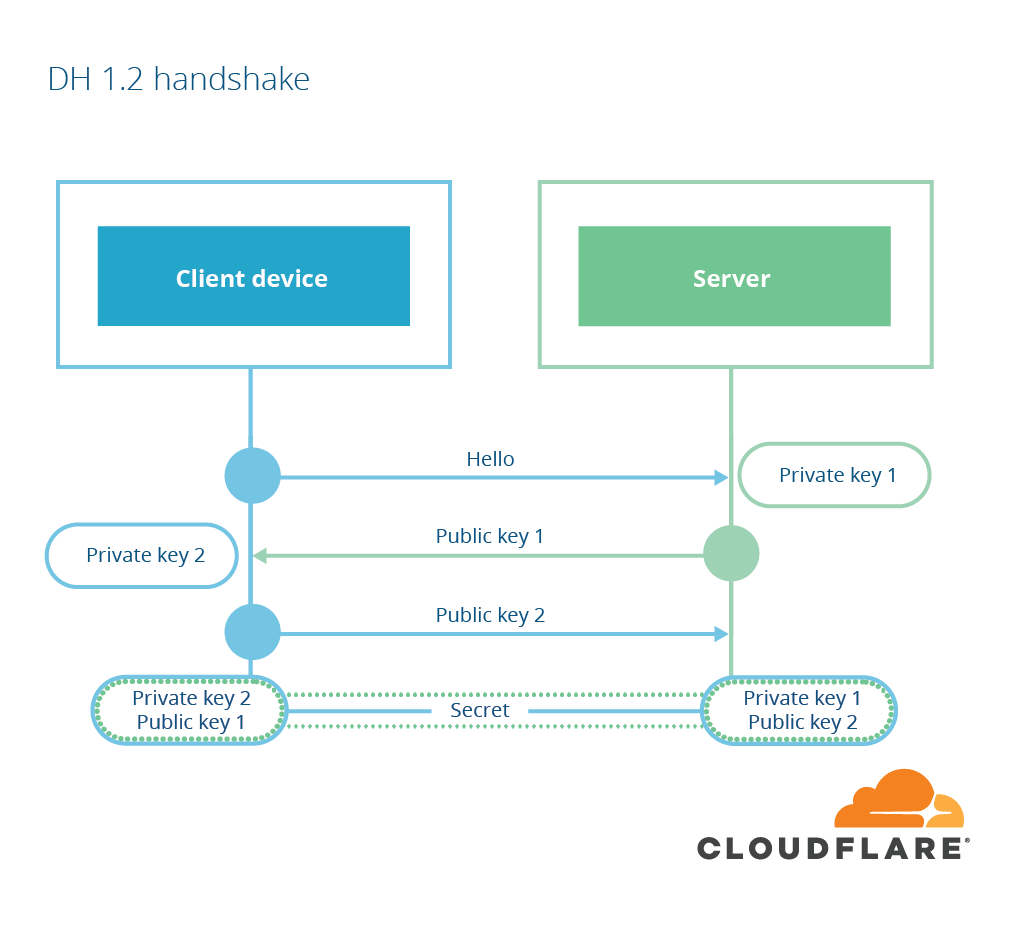
Source: Cloudflare
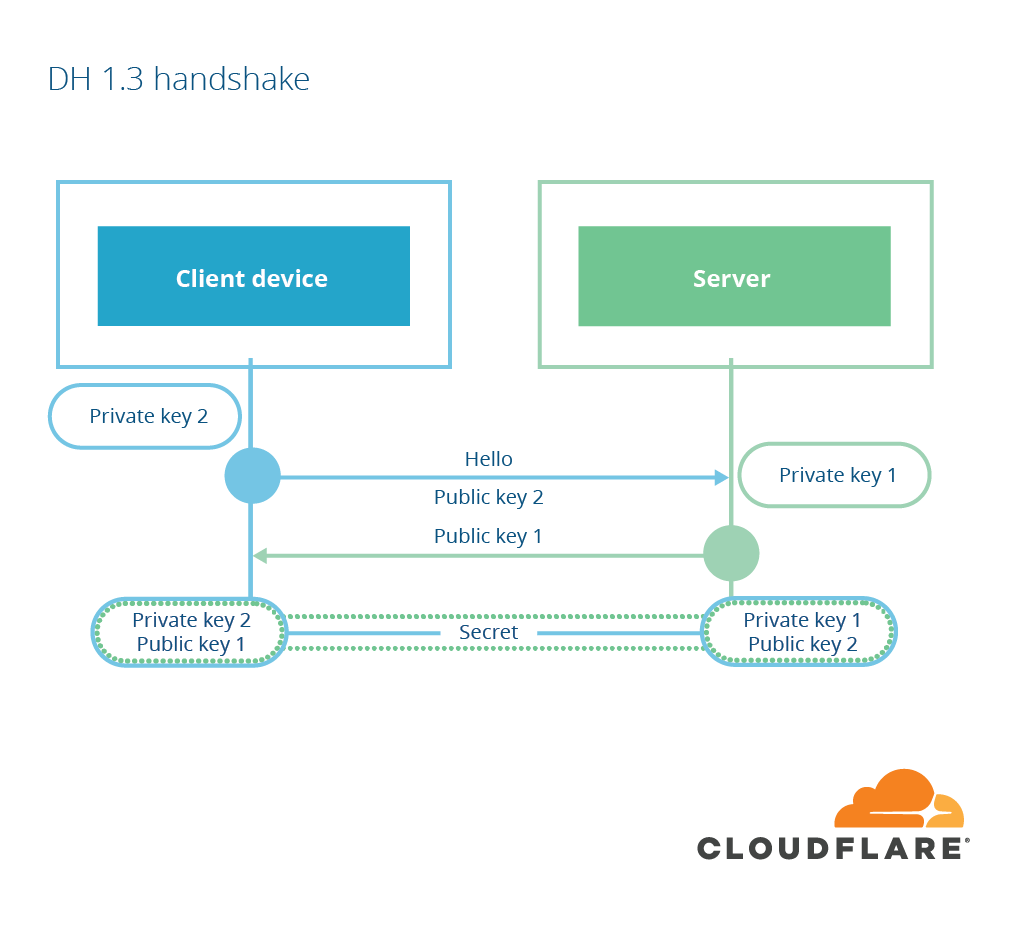
Source: Cloudflare
0-RTT resumption
- Client & server derive resumption master secret during session
- Can be stored session ID or as ticket on client
- Upon resumption, client uses PSK to encrypt data
- Improved performance, but ...
0-RTT attack

Source: Cloudflare
0-RTT attack
- Should only be used for stateless requests
- Requires awareness in application
- What Application Developers Need To Know About TLS Early Data (0RTT)
- For example Cloudflare only allows GET request without parameters
- Introducing Zero Round Trip Time Resumption (0-RTT)
More resources on TLS 1.3
Recommendations & powerful tools
SSL server test: Good
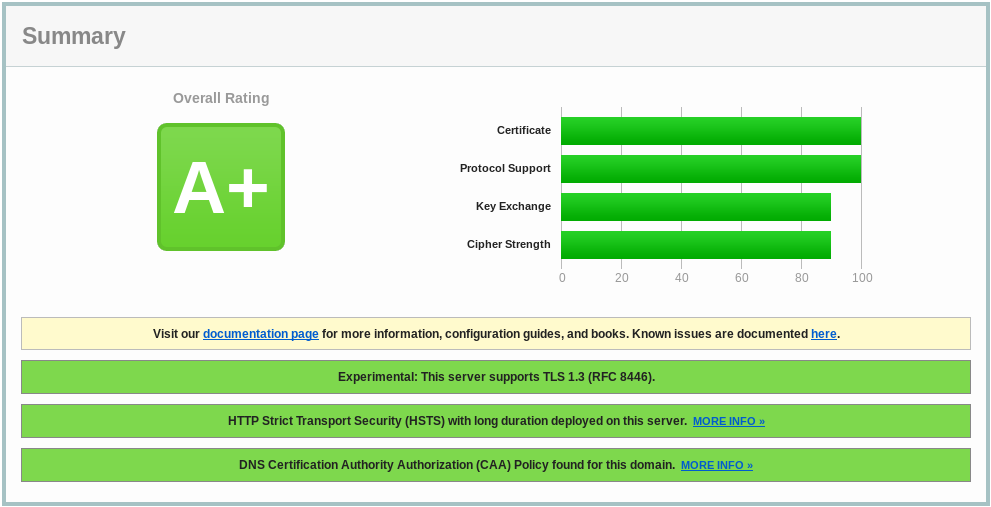
Source: SSL Labs
SSL server test: Bad

Source: SSL Labs
SSL server test: Ugly
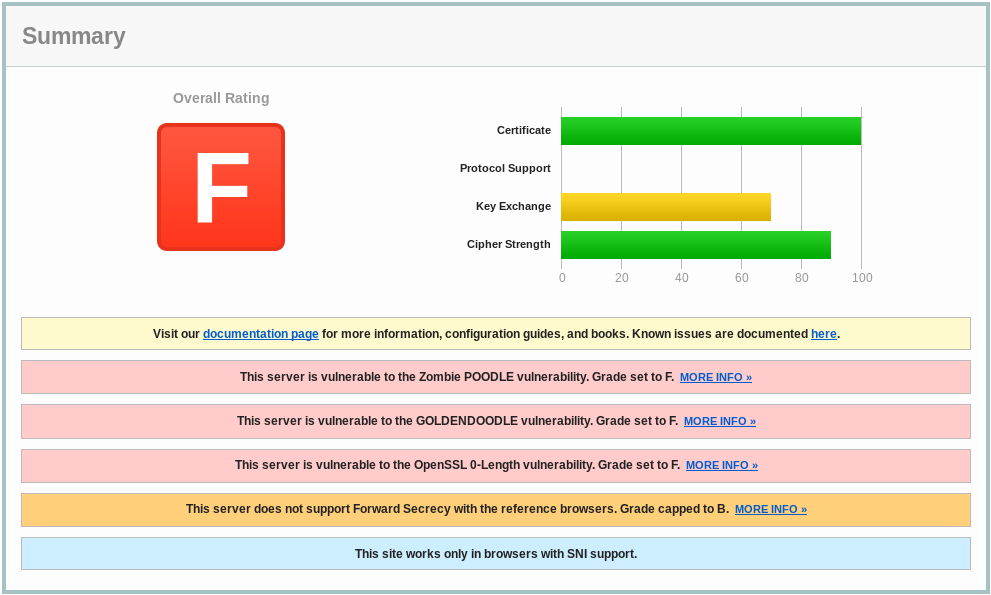
Source: SSL Labs